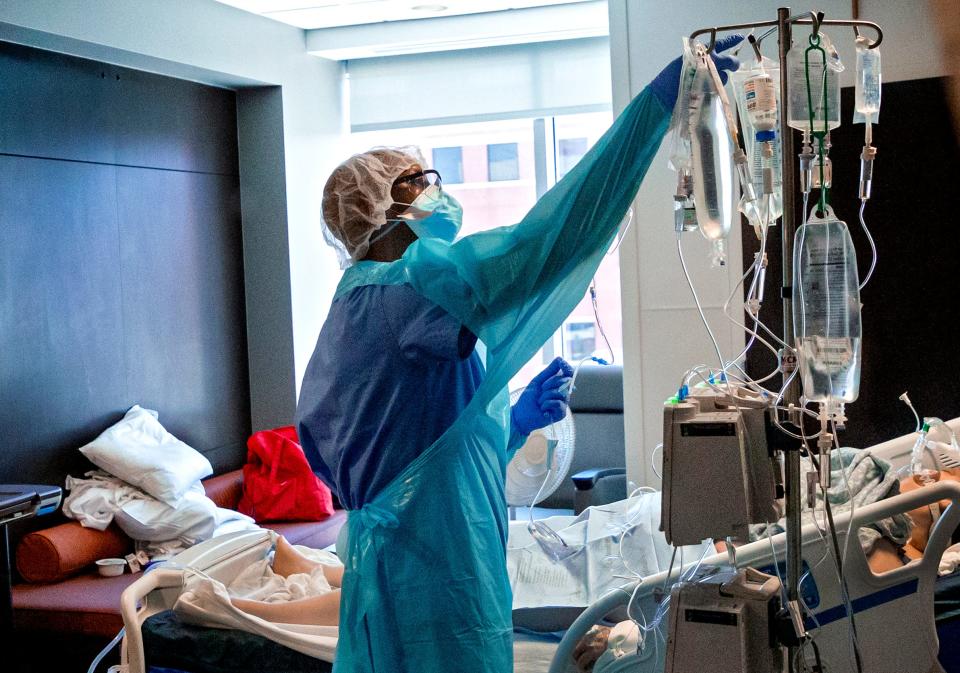Oklahomans die of COVID at higher rates than much of the US. What set us up for failure?
- Oops!Something went wrong.Please try again later.
After more than three years of the COVID-19 pandemic, Oklahoma finds itself near the top of the list of states with the highest death rates.
CDC data updated as of March 24 shows Oklahoma ranks 14th in the nation for COVID-19 death rates per capita. There have been 15,845 deaths from COVID-19 in Oklahoma, or 400 per 100,000 people.
In terms of cases, Oklahoma currently falls at 22nd in the nation with 1.29 million cases, or 32,696 cases per 100,000 people.
The nation has seen an average of 31,313 cases per 100,000 people, and 338 deaths per 100,000 people, according to the CDC. The state with the highest death rate, excluding New York and New York City which report COVID-19 data separately, is Arizona with 455 deaths per 100,000.
COVID-19 in Oklahoma tracker: Weekly updates on new cases, deaths, vaccines
What the experts are saying about Oklahoma's COVID-19 death rate

Dr. Dale Bratzler, the University of Oklahoma's chief COVID officer, said Oklahoma's high death rate is the result of vaccination rates and the prevalence of risk factors for severe COVID-19.
Some physicians and field experts predicted early on that Oklahoma would have a harder time with the virus than other states, according to an April 2020 article from Oklahoma Watch.
"There was a study that the CDC put out fairly early that color-coded counties for underlying risk factors for deaths from COVID," Bratzler said. "Oklahoma had lots of color."
How does Oklahoma compare to the nation? Check out the COVID Data Tracker
David Chansolme, infectious disease physician at INTEGRIS Southwest Medical Center, said how Oklahoma fared has nothing to do with Oklahoma's quality of medical care.
"We have fine hospitals, we have fine physicians, we have outstanding nurses," Chansolme said.
Oklahoma was dealing with a "handicap" from the beginning, Chansolme said — the state's residents' "baseline health."
Oklahomans are notoriously unhealthy. How did that affect COVID-19 deaths?

The Oklahoma State Department of Health said in a statement that the state's poor health ranking contributed to some COVID-19 deaths, and is also a reason heart disease and cancer are leading causes of death in Oklahoma.
Someone with diabetes is almost three times more likely to have a severe case of COVID-19, and about two times more likely to die from the infection, Chansolme said. The odds are about the same for a person with obesity who gets infected with COVID-19.
Oklahomans have diabetes and obesity "in spades," Chansolme said. While not the only factor, Chansolme said he believes poorer overall health "drove the death rates in Oklahoma."
According to the U.S. News and World Report Best States in 2021, 20% of Oklahomans between 19 and 64 do not have health insurance, and 36% of Oklahomans have obesity.
A study by Forbes, which used data for 21 metrics from the Kaiser Family Foundation and Centers for Disease Control and Prevention, listed Oklahoma as the eighth least healthiest state. The six least healthiest states, according to Forbes' study, are also in the top 10 states with the highest COVID-19 death rates — West Virginia, Mississippi, Kentucky, Alabama, Arkansas and Tennessee.
"It begins and ends with population health," Chansolme said. "We are an unhealthy state ... it makes sense that we were going to have more patients with severe COVID."
After 3 years of COVID-19, how has Oklahoma fared? A look at the numbers
How has Oklahoma's vaccination rate affected COVID-19 deaths?

Changing Oklahoma's unhealthiness is not a quick fix, but getting more Oklahomans vaccinated would have "stacked the deck in our favor," Chansolme said.
Bratzler said vaccination is still the best way to prevent hospitalization and death from COVID-19.
Oklahoma was ahead of most states in its vaccine rollout, but soon fell behind. Today, only about two-thirds of Oklahomans are vaccinated, which Bratzler credits to misinformation and as a driving factor in Oklahoma's death rates along with poor health.
"Studies show that in the elderly, even, somebody that is unvaccinated is about 14 times more likely to die than a similarly aged, vaccinated person," Bratzler said. "So vaccines are still our most important intervention to reduce the complications in the disease."
Long COVID has some weird symptoms. Face blindness may be one them.
Was poor testing a factor in the disparity between Oklahoma's COVID-19 cases and death rates?
There's a disparity between Oklahoma's rate of COVID-19 cases, which was about average at 23rd in the nation, and the rate that Oklahomans died of the virus, 14th in the nation.
Bratzler said he didn't believe this disparity could be blamed on a poor testing program in Oklahoma.
"The reality is, we had pretty robust testing pretty quickly across the state," he said.
This article originally appeared on Oklahoman: Why Oklahoma has one of highest COVID-19 death rates in America

